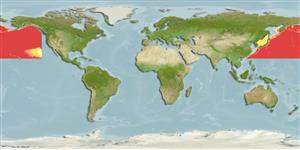分類 / Names
俗名 | 同種異名 | Catalog of Fishes(屬, 種) | ITIS | CoL | WoRMS | Cloffa
Teleostei >
Stomiiformes (Lightfishes and dragonfishes)
巨口魚目 (Lightfishes and dragonfishes) >
Gonostomatidae (Bristlemouths)
鑽光魚科 (Bristlemouths)
Etymology: Cyclothone: Greek, kyklothen, in circle, around (Ref. 45335).
More on author: Gilbert.
Environment: milieu / climate zone / depth range / distribution range
生態學
海洋 深海區的; 深度上下限 298 - 4938 m (Ref. 58302), usually 400 - 2400 m (Ref. 58302). 深水域; 64°N - 20°N, 105°E - 130°W
North Pacific: temperate and subtropical, from southern Japan to Baja California, from 21°N and into the Bering Sea.
北太平洋: 在排除美國加州的亞熱帶而靠近北極的區域中廣泛分佈。
大小 / 重量 / 年齡
Maturity: Lm ? range ? - ? cm
Max length : 6.2 cm SL 雄魚/尚未辨別雌雄; (Ref. 559)
背棘 (總數): 0; 背的軟條 (總數): 12-15; 臀棘 0; 臀鰭軟條: 17 - 20; 脊椎骨: 31 - 33. Body dark-brown or black; margin of scale pockets especially dark; area immediately anterior to anal origin densely pigmented and not transparent; peritoneum black, ending above area between 3rd and 4th VAV, usually invisible from the outside (Ref. 559). Gill lamellae free and reduced (Ref. 559).
身體深褐色或黑色的; 鱗囊的邊緣尤其深色的; 區域緊鄰濃密地被有顏色而不是的臀鰭起點之前透明的; 腹膜黑色 , 在第三與第 4個 VAV 之間的區域上面的終止, 通常外面的看不見的從.(參考文獻 559) 鰓小片分離而且縮小的.(參考文獻 559)
Meso- to bathypelagic (Ref. 58302). Inhabits deep water and is only captured with special equipment. Lipid content is 4.0 % in fresh body weight and wax ester is 58.4 % in total lipid (Ref. 9193). Protandrous hermaphrodite, oviparous with planktonic eggs and larvae (Ref. 35800).
中層 到深海區的.(參考文獻 58302) 棲息於深水域而且只被用特別的儀器捕獲。 體脂含量在新鮮的體重中是 4.0% ,而且蠟脂在總脂質中是 58.4% 。 (參考文獻 9193) 雄性先熟的雌雄同體, 卵生的卵與仔魚為浮游性.(參考文獻 35800)
Life cycle and mating behavior
成熟度 | 繁殖 | 產卵場 | 卵 | 孕卵數 | 仔魚
Oviparous (Ref. 35800).北太平洋: 在排除美國加州的亞熱帶而靠近北極的區域中廣泛分佈。
Masuda, H., K. Amaoka, C. Araga, T. Uyeno and T. Yoshino, 1984. The fishes of the Japanese Archipelago. Vol. 1. Tokai University Press, Tokyo, Japan. 437 p. (text). (Ref. 559)
人類使用
更多資訊
參考文獻養殖養殖資訊品種遺傳學Electrophoreses遺傳率疾病加工NutrientsMass conversion
合作者照片Stamps, Coins Misc.聲音神經毒速度泳型鰓區Otoliths腦重體重比眼睛色素
工具
特別的報告
下載 XML
網路資源
Estimates based on models
Preferred temperature (Ref.
123201): 1.7 - 7.3, mean 2.4 °C (based on 579 cells).
Phylogenetic diversity index (Ref.
82804): PD
50 = 0.5001 [Uniqueness, from 0.5 = low to 2.0 = high].
Bayesian length-weight: a=0.00389 (0.00171 - 0.00885), b=2.99 (2.79 - 3.19), in cm total length, based on LWR estimates for this (Sub)family-body shape (Ref.
93245).
營養階層 (Ref.
69278): 3.1 ±0.3 se; based on size and trophs of closest relatives
回復力 (Ref.
120179): 高度, 族群倍增時間少於 15個月 (Preliminary K or Fecundity.).
Fishing Vulnerability (Ref.
59153): Low vulnerability (10 of 100).
